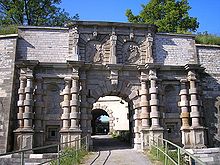Sophie of Braunschweig-Lüneburg

Sophie of Brunswick-Lüneburg (* 30th October 1563 in Celle , † January 14 . Jul / 24 January 1639 greg. In Nuremberg ) came from the house of Brunswick-Lüneburg and was by marriage Margravine of Brandenburg-Ansbach and Brandenburg-Kulmbach and Duchess von Jägerndorf .
Life
Sophie was the eldest child of Duke Wilhelm von Braunschweig-Lüneburg (1535–1592) from his marriage to Dorothea (1549–1614), daughter of King Christian III. from Denmark .
She married Margrave Georg Friedrich I of Brandenburg-Ansbach-Kulmbach (1539-1603) in Dresden on May 3, 1579 . Georg Friedrich was the last of the older line of the Franconian Hohenzollern and as margrave of the margravate of Ansbach and Kulmbach , Silesian Duke of Jägerndorf ( Krnov ) and guardian administrator of the Duchy of Prussia, a powerful figure of his time. His first wife Elisabeth von Brandenburg-Küstrin died in 1578 and like his first, Georg Friedrich's second marriage to Sophie remained childless, which is why his inheritance had to be regulated by the Gera house contract . Sophie's childlessness motivated her husband to increase politics in the interests of his entire Hohenzollern family.
Instead of having a child of her own, she took in her youngest sister, Sibylle, who was then only five years old. Her last big trip with her husband took her in September 1599 to Heldburg and Coburg to the side camp of her sister Margarethe with Duke Johann Casimir von Sachsen-Coburg . Sophie, who returned to her birth family after the death of her husband in 1603, survived her husband by 36 years. Sophie often stayed in Nuremberg with her sisters, Countess Clara von Schwarzburg and Duchess Sibylle von Braunschweig-Dannenberg, where she also died. She was buried in the Nuremberg Lorenz Church.
The renaissance portal of the Hohenzollern fortress Wülzburg shows the coat of arms of Georg Friedrich next to that of his wife Sophie.
Individual evidence
- ↑ Adolph Friedrich Riedel: Codex diplomaticus Brandenburgensis: Collection of documents, chronicles and other sources for the history of the Margraviate of Brandenburg and its regents, Volume 1 , FH Morin, 1867, p. 243
- ↑ Andrea Baresel-Brand: Funerary monuments of northern European royal houses in the age of the Renaissance 1550-1650, Volume 9 of Bau + Kunst , Verlag Ludwig, 2007, p. 145
- ^ For the princely supplement of Duke Johann Casimir's at Heldburg Castle and in Coburg see: Norbert Klaus Fuchs: Das Heldburger Land - a historical travel guide ; Rockstuhl Publishing House, Bad Langensalza, 2013, ISBN 978-3-86777-349-2
- ↑ Erik Margraf: The Wedding Sermon of the Early Modern Age , Herbert Utz Verlag, 2007, p. 274
- ↑ Franz von Soden: War and Moral History of the Imperial City of Nuremberg , Bläsing, 1860, pp. 11, 64, 478
- ↑ Archived copy ( memento of the original from December 19, 2009 in the Internet Archive ) Info: The archive link was inserted automatically and has not yet been checked. Please check the original and archive link according to the instructions and then remove this notice.
- ^ Daniel Burger: The state fortresses of the Hohenzollern in Franconia and Brandenburg in the age of the Renaissance , Beck'sche Verlagsbuchhandlung, 2000, p. 132
Web links
| personal data | |
|---|---|
| SURNAME | Sophie of Braunschweig-Lüneburg |
| BRIEF DESCRIPTION | Margravine of Brandenburg-Ansbach and Brandenburg-Kulmbach |
| DATE OF BIRTH | October 30, 1563 |
| PLACE OF BIRTH | Celle |
| DATE OF DEATH | January 24, 1639 |
| Place of death | Nuremberg |
